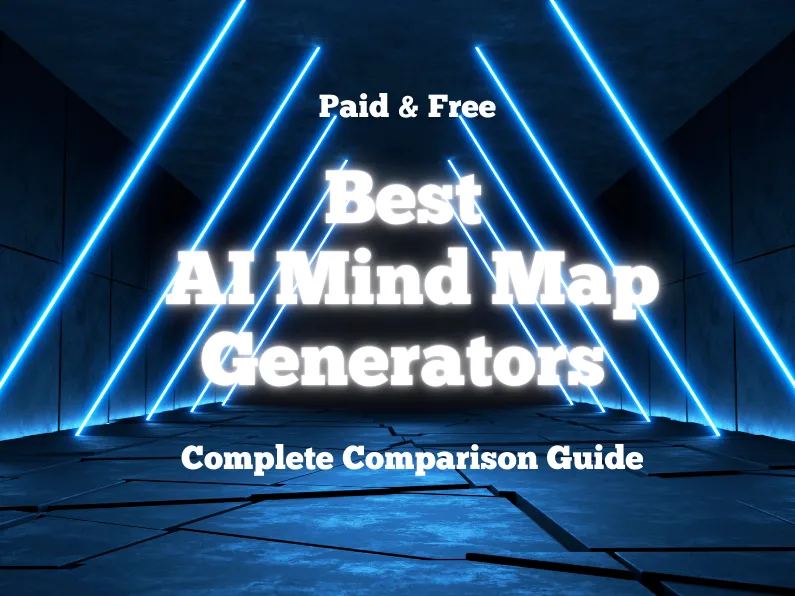Mind mapping remains one of the most effective methods to visually organize ideas, plan projects, and break down complex topics. In recent years, a new generation of AI‑powered mind map generators has emerged — these tools can automatically build structured maps from text, documents, web pages, or prompts, dramatically reducing manual effort.
In this article, I explore the top AI-based mind map tools in 2025–2026: how they differ, where they excel, their tradeoffs — and ultimately why iWeaver stands out as the most balanced, production-ready choice for most users. The comparison combines feature analysis, pricing, collaboration, and real‑world applicability.
Why Use an AI‑Powered Mind Map Tool?
Before diving into the tools, it helps to clarify what AI‑powered mind map generators offer over traditional manual mind mapping:
- Automatic structure generation: From a block of text, a URL, or a file (PDF, doc, etc.), the AI extracts main ideas, subtopics, and logical relationships — instantly producing a draft mind map.
- Idea expansion & discovery: Many tools don’t just map existing content, but generate related ideas, sub‑nodes or even to‑do lists — useful for brainstorming or project planning.
- Faster workflow & export: Instead of building from scratch, you get a ready outline you can refine, export, or turn into a presentation/document with minimal friction.
- Collaboration and flexibility: Cloud‑based tools allow real‑time teamwork, shared editing, version history — bringing mind mapping closer to team whiteboarding or project planning.
Given these capabilities, AI mind mapping is increasingly attractive for students, researchers, product teams, writers, and knowledge workers — especially when time and clarity matter.
Leading AI Mind Map Tools in 2025–2026
Here are some of the top tools frequently recommended across major reviews and ranking sites. I grouped them by their core strengths to help you choose based on your needs.
But while there are many options, not all deliver the balance of auto‑generation → editable output → export readiness → workflow integration. That’s where iWeaver aims to differentiate itself.
What a Good AI Mind Map Generator Should Provide
Based on reviews and the collective strengths of the tools above, a high‑quality AI mind map generator should ideally offer:
- Flexible input — Accept raw text, documents, web pages, PDFs, etc.
- Strong AI parsing & idea expansion — Extract main points, suggest subtopics, link related ideas.
- Clean, editable, and exportable output — Enables users to refine maps and export to formats like PNG, PPT, Markdown, or other docs.
- Collaboration and sharing (if team use) — Real‑time editing, version history, cloud sync, multi‑user access.
- Reasonable pricing or free tier for trials.
- Integration with user workflow — Works with docs, tasks, presentations, research tools.
Gap in the Market — Why Many Tools Are Good But Not Optimal
Despite the many tools available, there are tradeoffs:
- Tools focused on infinite canvas & whiteboarding (like Miro) often excel in collaboration, but their maps can feel loose and less structured — more like sticky-note boards than crisp mind maps.
- Tools focused on pure hand‑crafted mind maps (classic mind‑mapping software) often lack AI support — meaning manual effort is still required.
- AI-first tools sometimes generate good drafts, but their output can be rigid, lack polish, or be difficult to export into presentation‑ready formats.
- Many tools force you to stay within their ecosystem; integration with docs/PPT/knowledge workflows is limited.
In short: it’s hard to find a tool that balances AI power + structured output + workflow readiness + usability. That’s why a well-designed “hybrid” solution can stand out.
Enter iWeaver: Bridging the Gap
That’s where iWeaver comes in. Based on your background and product vision, iWeaver is designed to deliver a well-rounded, efficient, and workflow‑friendly mind mapping experience.
What iWeaver Offers (and Why It Matters)
- Flexible inputs: Like AI-first tools, iWeaver accepts various inputs (document upload, URL, text) — making it suitable for knowledge work, research, meeting notes, or content planning.
- Clean, editable mind maps: The output is not a messy canvas, but a structured, easy-to-edit mind map — more like the classic mind‑map look, but generated instantly.
- Export & workflow readiness: Easy export to PPT, Markdown, image formats (PNG/SVG) — ideal for turning knowledge maps into slide decks, reports, or shareable documents.
- Balanced AI + manual control: iWeaver gives users control to refine automatically generated maps — so AI boosts efficiency without sacrificing flexibility.
- Suited for research & knowledge workers: Given your target audience (researchers, finance professionals, heavy note‑takers), iWeaver’s structured output and export capability is a big plus — especially when maps need to be reused, shared, or integrated into docs/presentations.
Why iWeaver Might Be the Most Practical Choice
While other tools excel in collaboration (Miro, MindMeister) or simple creative mapping (Ayoa), iWeaver hits a sweet spot for efficient, structured knowledge work — something many general-purpose tools don’t prioritize. Especially if you work solo or in small teams and care about clean output and export.
If you demand a tool that helps you go from “raw info → organized mind map → usable document/slides” with minimal friction, iWeaver could well be the most practical solution now.
Detailed Comparison: iWeaver vs. Leading Tools
Here’s a comparison table focusing on core needs for knowledge‑heavy users (input flexibility, output quality, export, collaboration, workflow):
| Feature / Need | iWeaver | XMind AI | MindMeister | Miro | Ayoa |
| Input: text / document / URL / file | ✔️ Yes | ✔️ Yes | Basic text/prompt support | Prompt + board content | Prompt / idea‑based mapping |
| Automatic structure generation (nodes, hierarchy) | ✔️ Yes | ✔️ Yes | ✔️ Basic / moderate | ✔️ Yes — but more free‑form canvas | ✔️ Ideation focused; structure less strict |
| Editable clean mind‑map layout | ✔️ Yes | ✔️ Yes — classic map UI | Yes, but less polished than classic mind‑map tools | Editable canvas — may require manual cleanup | Editable, but more “creative map” than structured map |
| Export (PPT, doc, image, markdown) | ✔️ (PPT / doc / image / markdown) | Good: PNG, PDF, PPT, etc. | Basic export support | Canvas export / share link / screenshot | Basic export / share functions |
| Team collaboration / sharing / cloud | ✔️ (if needed) | ✔️ Yes | ✔️ Excellent for collaboration | ✔️ Strong collaboration & whiteboarding | ✔️ Yes, basic team support |
| Best suited for | Knowledge work, research, docs/slides | Classic‑style mind‑maps + flexibility | Team brainstorming | Workshops / whiteboard sessions | Creative idea‑generation / brainstorming |
In short: iWeaver combines the structured output and export readiness of classic mind‑map tools with the automation and flexibility of AI-first generators — giving you arguably the best trade‑off for productivity and reuse.
Who Benefits Most from iWeaver
- Researchers / knowledge workers — process white papers, reports, academic articles into structured mind maps; export as Markdown or PPT for reports or presentations.
- Product managers / content planners — outline product docs, feature plans, SEO content maps, project flows; easily convert to slides or docs.
- Students / learners — import lecture notes, reading materials, create study maps quickly, then refine and export.
- Solo creators / consultants — quickly map your ideas or research, polish, and deliver professional-looking mind maps or docs — without juggling multiple tools.
- Small teams / distributed co‑workers — collaborate when needed, but without the overhead of heavy whiteboard tools if you only need structured output.
Given your background (AI SaaS, content production, B2C expansion, knowledge tools), iWeaver seems especially aligned with your use cases: efficient knowledge capture, easy export to deliverables, and flexibility for both solo and collaborative work.
Recommendations & When to Use What
- If you often brainstorm in teams or need a free‑form, flexible canvas for large workshops → Miro (or MindMeister) might be more suitable.
- If you prefer classical mind‑map style with strong mapping UI and occasional AI support → XMind AI is a solid choice.
- If you value simplicity, quick idea generation, creative brainstorming → Ayoa or lighter tools may suffice.
- If your goal is structured, exportable mind maps from documents / content, ready for reports or presentations → iWeaver AI Mind Map Generator is likely the best compromise of power and usability.
For many knowledge-intensive users (research, writing, product, content) — that balance matters more than absolute creative flexibility.
Why iWeaver Makes Sense (for You & Many Others)
While dozens of AI-powered mind map tools exist, few deliver balanced, production-ready mapping: automatic generation of ideas, clean structured output, and easy export for re-use. Many tools favor either free-form creativity (whiteboards, sticky notes) or simple brainstorming — great for workshops, but not ideal when you need tidy output for slides, reports, or internal knowledge bases.
iWeaver fills that gap: it’s not just about throwing ideas on a board, but capturing, structuring, and transforming them into organized, shareable knowledge. For researchers, product teams, content creators, and anyone dealing with complex information, iWeaver can save time, reduce friction, and improve overall output quality.
If you want to see how fast structured mind maps can be generated from your documents or notes, try iWeaver’s AI Mind Map Generator — free trial available.



